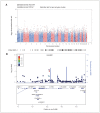A translational systems biology approach in both animals and humans identifies a functionally related module of accumbal genes involved in the regulation of reward processing and binge drinking in males
- PMID: 26679926
- PMCID: PMC4853210
- DOI: 10.1503/jpn.150138
A translational systems biology approach in both animals and humans identifies a functionally related module of accumbal genes involved in the regulation of reward processing and binge drinking in males
Abstract
Background: The mesolimbic dopamine system, composed primarily of dopaminergic neurons in the ventral tegmental area that project to striatal structures, is considered to be the key mediator of reinforcement-related mechanisms in the brain. Prompted by a genome-wide association meta-analysis implicating the Ras-specific guanine nucleotide-releasing factor 2 (RASGRF2) gene in the regulation of alcohol intake in men, we have recently shown that male Rasgrf2(-/-) mice exhibit reduced ethanol intake and preference accompanied by a perturbed mesolimbic dopamine system. We therefore propose that these mice represent a valid model to further elucidate the precise genes and mechanisms regulating mesolimbic dopamine functioning.
Methods: Transcriptomic data from the nucleus accumbens (NAcc) of male Rasgrf2(-/-) mice and wild-type controls were analyzed by weighted gene coexpression network analysis (WGCNA). We performed follow-up genetic association tests in humans using a sample of male adolescents from the IMAGEN study characterized for binge drinking (n = 905) and ventral striatal activation during an fMRI reward task (n = 608).
Results: The WGCNA analyses using accumbal transcriptomic data revealed 37 distinct "modules," or functionally related groups of genes. Two of these modules were significantly associated with Rasgrf2 knockout status: M5 (p < 0.001) and M6 (p < 0.001). In follow-up translational analyses we found that human orthologues for the M5 module were significantly (p < 0.01) enriched with genetic association signals for binge drinking in male adolescents. Furthermore, the most significant locus, originating from the EH-domain containing 4 (EHD4) gene (p < 0.001), was also significantly associated with altered ventral striatal activity in male adolescents performing an fMRI reward task (pempirical < 0.001).
Limitations: It was not possible to determine the extent to which the M5 module was dysregulated in Rasgrf2(-/-) mice by perturbed mesolimbic dopamine signalling or by the loss of Rasgrf2 function in the NAcc.
Conclusion: Taken together, our findings indicate that the accumbal M5 module, initially identified as being dysregulated in male Rasgrf2(-/-) mice, is also relevant for human alcohol-related phenotypes potentially through the modulation of reinforcement mechanisms in the NAcc. We therefore propose that the genes comprising this module represent important candidates for further elucidation within the context of alcohol-related phenotypes.
Figures



References
-
- Blomeyer D, Treutlein J, Esser G, et al. Interaction between CRHR1 gene and stressful life events predicts adolescent heavy alcohol use. Biol Psychiatry. 2008;63:146–51. - PubMed
-
- Chassin L, Pitts S, Prost J. Binge drinking trajectories from adolescence to emerging adulthood in a high-risk sample: predictors and substance abuse outcomes. J Consult Clin Psychol. 2002;70:67–78. - PubMed
-
- Chou SP, Pickering R. Early onset of drinking as a risk factor for lifetime alcohol-related problems. Br J Addict. 1992;87:1199–204. - PubMed
